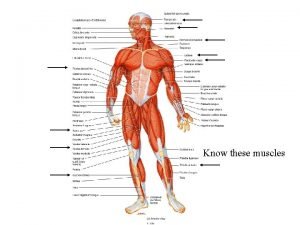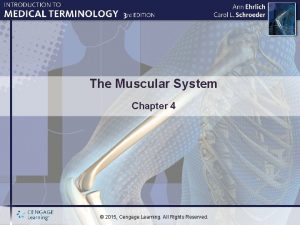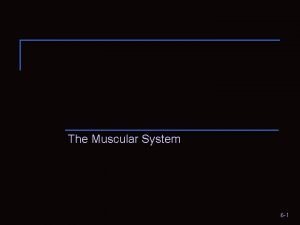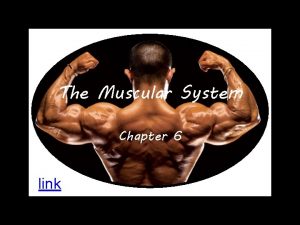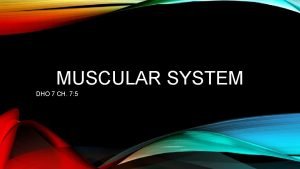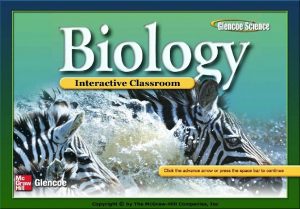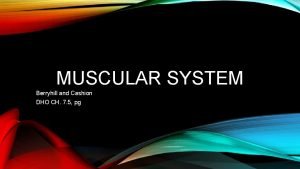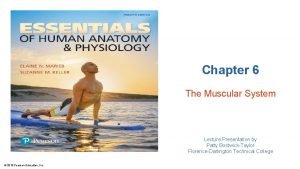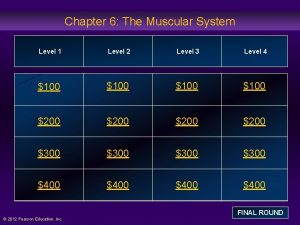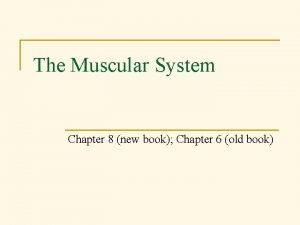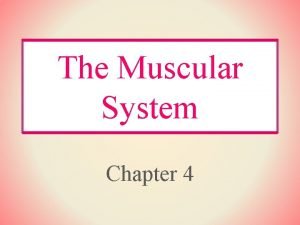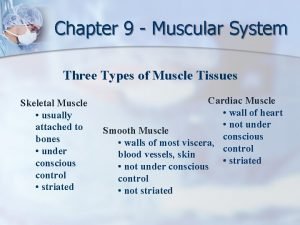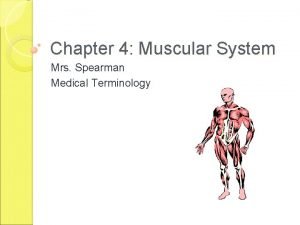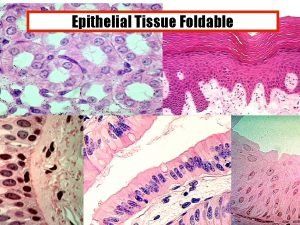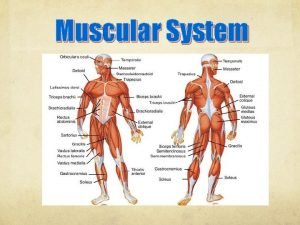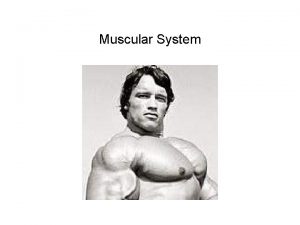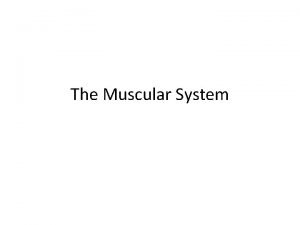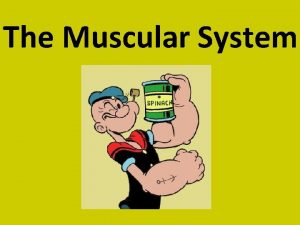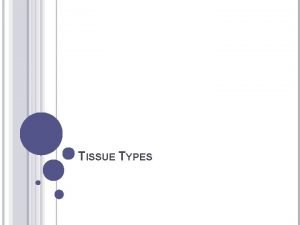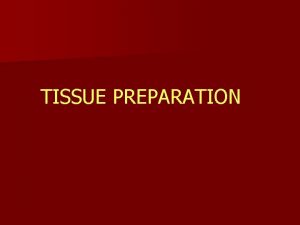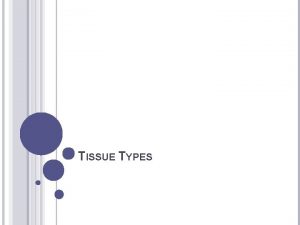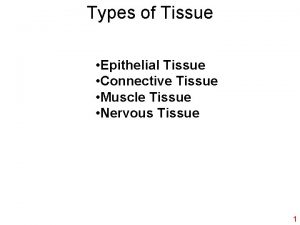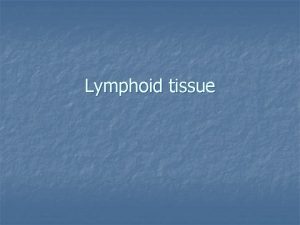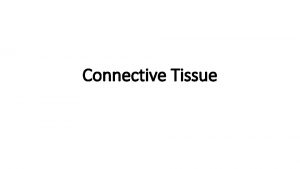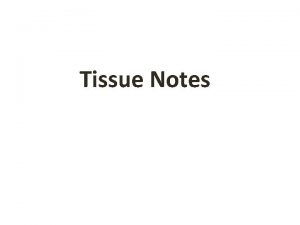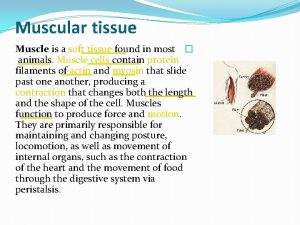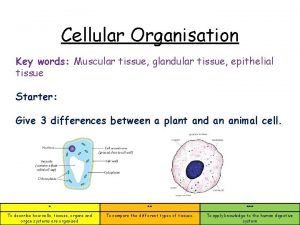Chapter 7 The Muscular System INTRODUCTION Muscular tissue



































- Slides: 35

Chapter 7 The Muscular System

INTRODUCTION • Muscular tissue enables the body and its parts to move – Three types of muscle tissue exist in body (see Chapter 3) – Movement caused by muscle cells (called fibers) shortening, or contracting – Muscle movement occurs when chemical energy (obtained from food) is converted into mechanical energy

MUSCLE TISSUE • Types of muscle tissue (Figure 7 -1) – Skeletal muscle—also called striated or voluntary muscle • Microscope reveals crosswise stripes or striations • Contractions can be voluntarily controlled – Cardiac muscle—composes bulk of heart • Cardiac muscle fibers branch frequently • Characterized by unique dark bands called intercalated disks • Interconnected nature of cardiac muscle fibers allows heart to contract efficiently as a


MUSCLE TISSUE • Types of muscle tissue (cont. ) – Nonstriated muscle, or involuntary muscle—also called smooth or visceral muscle • Lacks cross stripes or striations when seen under a microscope; appears smooth • Found in walls of hollow visceral structures such as digestive tract, blood vessels, and ureters • Contractions not under voluntary control; movement caused by contraction is involuntary

STRUCTURE OF SKELETAL MUSCLE • Composition—mainly striated muscle fibers and connective tissue – Most skeletal muscles extend from one bone across a joint to another bone – Parts of a skeletal muscle • Origin—attachment to the bone that remains relatively stationary or fixed when movement at the joint occurs • Insertion—point of attachment to the bone that moves when a muscle contracts • Body—main part of the muscle – Muscles attach to bone by tendons—strong cords of fibrous connective tissue; some tendons enclosed in synovial-lined tubes and are lubricated by synovial fluid; tubes called tendon sheaths

STRUCTURE OF SKELETAL MUSCLE • Microscopic structure (Figure 7 -3) – Contractile cells called fibers—grouped into bundles – Fibers contain thick myofilaments (containing the protein myosin) and thin myofilaments (composed of actin) – Basic functional (contractile) unit called sarcomere • Sarcomeres separated from each other by dark bands called Z lines • Sliding filament model explains mechanism of contraction – Thick and thin myofilaments slide past each other as a muscle contracts – Contraction requires calcium and energy-rich ATP molecules



FUNCTIONS OF SKELETAL MUSCLE • Movement – Muscles produce movement; as a muscle contracts, it pulls the insertion bone closer to the origin bone; movement occurs at the joint between the origin and the insertion • Groups of muscles usually contract to produce a single movement – Prime mover—muscle whose contraction is mainly responsible for producing a given movement – Synergist—muscle whose contractions help the prime mover produce a given movement – Antagonist—muscle whose actions oppose the

FUNCTIONS OF SKELETAL MUSCLE • Posture – A specialized type of muscle contraction, called tonic contraction, enables us to maintain body position • In tonic contraction, only a few of a muscle’s fibers shorten at one time • Tonic contractions produce no movement of body parts • Tonic contractions maintain muscle tone called posture – Good posture reduces strain on muscles, tendons, ligaments, and bones – Poor posture causes fatigue and may lead to deformity

FUNCTIONS OF SKELETAL MUSCLE • Heat production – Survival depends on the body’s ability to maintain a constant body temperature • Fever—an elevated body temperature— often a sign of illness • Hypothermia—a reduced body temperature – Contraction of muscle fibers produces most of the heat required to maintain normal body temperature


FATIGUE • Reduced strength of muscle contraction • Caused by repeated muscle stimulation without adequate periods of rest • Repeated muscular contraction depletes cellular ATP stores and outstrips the ability of the blood supply to replenish oxygen and nutrients

FATIGUE • Contraction in the absence of adequate oxygen produces lactic acid, which contributes to muscle soreness • Oxygen debt—term used to describe the metabolic effort required to burn excess lactic acid that may accumulate during prolonged periods of exercise; the body is attempting to return the cells’ energy and oxygen reserves to pre-exercise levels

What does Fatigue look like. http: //www. youtube. com/watch? v=Vb. Ws. QMabcz. M&p=756 EE 379 B 0 E 6 6 FBD&playnext=1&index=21 http: //www. youtube. com/watch? v=MTn 1 v 5 TGK_w Or is that perseverance?

ROLE OF OTHER BODY SYSTEMS IN MOVEMENT • Muscle functioning depends on the functioning of many other parts of the body • Most muscles cause movements by pulling on bones across movable joints • Respiratory, circulatory, nervous, muscular, and skeletal systems play essential roles in producing normal movements • Multiple sclerosis, brain hemorrhage, and spinal cord injury are examples of how pathological conditions in other body organ systems can dramatically affect movement

MOTOR UNIT (Figure 7 -4) • Stimulation of a muscle by a nerve impulse is required before a muscle can shorten and produce movement • A motor neuron is the specialized nerve that transmits an impulse to a muscle, causing contraction • A neuromuscular junction is the specialized point of contact between a nerve ending and the muscle fiber it innervates • A motor unit is the combination of a motor neuron with the muscle fiber or fibers it innervates



MUSCLE STIMULUS • A muscle will contract only if an applied stimulus reaches a certain level of intensity – A threshold stimulus is the minimal level of stimulation required to cause a muscle fiber to contract • Once stimulated by a threshold stimulus, a muscle fiber will contract completely, a response called all or none

MUSCLE STIMULUS • Different muscle fibers in a muscle are controlled by different motor units having different threshold-stimulus levels – Although individual muscle fibers always respond all or none to a threshold stimulus, the muscle as a whole does not – Different motor units responding to different threshold stimuli permit a muscle as a whole to execute

TYPES OF SKELETAL MUSCLE CONTRACTION • Twitch and tetanic contractions – Twitch contractions are laboratory phenomena and do not play a significant role in normal muscular activity; they are a single contraction of muscle fibers caused by a single threshold stimulus – http: //www. youtube. com/watch? v=pe. SW znl 5 p. WI&feature=related – Tetanic contractions are sustained and steady muscular contractions caused by a series of stimuli bombarding a muscle in rapid succession

TYPES OF SKELETAL MUSCLE CONTRACTION • Isotonic contractions – Contraction of a muscle that produces movement at a joint because the muscle changes length – During concentric contractions, the muscle shortens insertion end of the muscle to move toward the point of origin – During eccentric contractions, the muscle lengthens under tension, thus moving the insertion away from the origin – Most types of body movements such as walking and running are produced by isotonic contractions

TYPES OF SKELETAL MUSCLE CONTRACTION • Isometric contractions – Isometric contractions are muscle contractions that do not produce movement; the muscle as a whole does not shorten – Although no movement occurs during isometric contractions, tension within the muscle increases

EFFECTS OF EXERCISE ON SKELETAL MUSCLES • Exercise, if regular and properly practiced, improves muscle tone and posture, results in more efficient heart and lung functioning, and reduces fatigue • Muscles change in relation to the amount of work they normally do – Prolonged inactivity causes disuse atrophy – Regular exercise increases muscle size, called hypertrophy

EFFECTS OF EXERCISE ON SKELETAL MUSCLES • Strength training is exercise involving contraction of muscles against heavy resistance – Strength training increases the number of myofilaments in each muscle fiber, and as a result, the total mass of the muscle increases – Strength training does not increase the number of muscle fibers • Endurance training is exercise that increases a muscle’s ability to sustain moderate exercise over a long period; it is sometimes called aerobic training – Endurance training allows more efficient delivery of oxygen and nutrients to a muscle via increased blood flow – Endurance training does not usually result in muscle hypertrophy

SKELETAL MUSCLE GROUPS (Table 7 -1) • Muscles of the head and neck (Figure 7 -7) – Facial muscles • Orbicularis oculi • Orbicularis oris • Zygomaticus – Muscles of mastication • Masseter • Temporal – Sternocleidomastoid—flexes head – Trapezius—elevates shoulders and extends head


SKELETAL MUSCLE GROUPS • Muscles that move the upper extremities – Pectoralis major—flexes upper arm – Latissimus dorsi—extends upper arm – Deltoid—abducts upper arm – Biceps brachii—flexes forearm – Triceps brachii—extends forearm

SKELETAL MUSCLE GROUPS • Muscles of the trunk (Figure 7 -8) – Abdominal muscles • • Rectus abdominis External oblique Internal oblique Transversus abdominis – Respiratory muscles • Intercostal muscles • Diaphragm


SKELETAL MUSCLE GROUPS • Muscles that move the lower extremities – – Iliopsoas—flexes thigh Gluteus maximus—extends thigh Adductor muscles—adduct thighs Hamstring muscles—flex lower leg • Semimembranosus • Semitendinosus • Biceps femoris – Quadriceps femoris group—extend lower leg • Rectus femoris • Vastus muscles – Tibialis anterior—dorsiflexes foot – Gastrocnemius—plantar flexes foot – Peroneus group—flex foot

MOVEMENTS PRODUCED BY SKELETAL MUSCLE CONTRACTIONS (Figures 7 -9 through 7 -11) • Flexion—movement that decreases the • • angle between two bones at their joint: bending Extension—movement that increases the angle between two bones at their joint: straightening Abduction—movement of a part away from the midline of the body Adduction—movement of a part toward the midline of the body Rotation—movement around a longitudinal

 Differentiate muscular strength from muscular endurance
Differentiate muscular strength from muscular endurance Function of muscular tissue
Function of muscular tissue Muscle
Muscle Muscular tissue
Muscular tissue How is aerolar tissue different than aerenchyma tissue?
How is aerolar tissue different than aerenchyma tissue? Dorsiflexion word parts
Dorsiflexion word parts Muscular system figure
Muscular system figure The muscular system chapter 6
The muscular system chapter 6 Chapter 6 the muscular system figure 6-9
Chapter 6 the muscular system figure 6-9 Test chapter 7:5 muscular system
Test chapter 7:5 muscular system Chapter 9 muscular system
Chapter 9 muscular system Chapter 32 section 3 the muscular system answer key
Chapter 32 section 3 the muscular system answer key Chapter 6 the muscular system figure 6-9
Chapter 6 the muscular system figure 6-9 Chapter 7:5 muscular system
Chapter 7:5 muscular system Chapter 6 the muscular system
Chapter 6 the muscular system Chapter 4 the muscular system labeling exercises
Chapter 4 the muscular system labeling exercises Chapter 6 the muscular system
Chapter 6 the muscular system Chapter 6 the muscular system
Chapter 6 the muscular system Chapter 10 the muscular system
Chapter 10 the muscular system Chapter 8 the muscular system
Chapter 8 the muscular system Inner quads
Inner quads Cross section thigh
Cross section thigh Define myocele
Define myocele Introduction to epithelial tissue pogil answer key
Introduction to epithelial tissue pogil answer key Hình ảnh bộ gõ cơ thể búng tay
Hình ảnh bộ gõ cơ thể búng tay Slidetodoc
Slidetodoc Bổ thể
Bổ thể Tỉ lệ cơ thể trẻ em
Tỉ lệ cơ thể trẻ em Gấu đi như thế nào
Gấu đi như thế nào Chụp phim tư thế worms-breton
Chụp phim tư thế worms-breton Hát lên người ơi
Hát lên người ơi Các môn thể thao bắt đầu bằng tiếng đua
Các môn thể thao bắt đầu bằng tiếng đua Thế nào là hệ số cao nhất
Thế nào là hệ số cao nhất Các châu lục và đại dương trên thế giới
Các châu lục và đại dương trên thế giới Cong thức tính động năng
Cong thức tính động năng Trời xanh đây là của chúng ta thể thơ
Trời xanh đây là của chúng ta thể thơ


